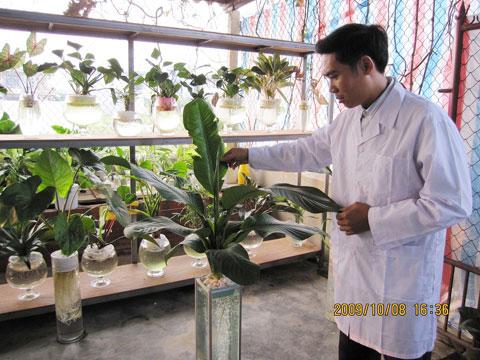Planting bonsai by hydroponic method
Having been successful with many models of growing vegetables and fruits such as tomatoes, cabbage, lettuce . recently, Nguyen Van Quy, a lecturer of the Department of Agronomy, Hue University of Agriculture and Forestry, was successful with the research model of growing ornamental plants by means of hydroponic
From a young age, Quy has a passion for growing ornamental plants, especially a nursery for germination plants. When he became a lecturer, in addition to class hours, Quy also spent a lot of time researching scientific topics to serve his teaching. To accomplish that, Quy went through many difficulties. Must pay pocket money, mobilize capital from the family to buy hundreds of different types of ornamental plants grown by hydroponic methods that he has thickly researched.
Understand tree characteristics
According to the regulation, if planting ornamental leaves in soil pots requires very careful selection of varieties, soil, fertilizer and a reasonable irrigation regime, bonsai plantation is simple and more convenient. Just a glass basin, a plastic basket of the right size for the tree, then separate the tree from the soil pot, wash the roots with water, cut the rotten roots and damaged roots, keep the main roots and strong roots. Then, place the tree in a plastic basket and mix about 10 drops of nutrient water into the glass water bottle to absorb the nutrients.

Mr. Nguyen Van Quy's ornamental tree camp.Photo: L. Duong
The 'fastidious' ornamental plants such as bamboo, bell flower . can be grown in this environment, even growing cacti, a plant that doesn't like water. In addition, growers can combine ornamental fish farming, creating a harmonious feng shui form in the home or office, suitable for today's bonsai hobby.'After 20 days when the root system grows well, it is possible to add nutrient solution once. Thanks to the water stored in the bottle, the tree has a faster growth rate than normal, limiting pests and diseases and environmental pollution. Life expectancy of trees is two to three times higher than that of growing in the soil ', Mr. Quy explained.
'The research process of hydroponic cultivation is not difficult, but the process of preparing nutrients is challenging . Many chemicals have very small doses, must use small scales to balance dosage' , Quy said.
By his great passion, he succeeded with a formulation of 16 chemicals, named NQ2, as necessary in a soil environment.
Ready to transfer technology
The model of planting hydroponic plants in some advanced countries such as the US, Australia, Canada . is quite popular, but these types of nutrient solutions sold in Vietnam market are quite expensive. Therefore, the formula of preparing NQ2 solution was thickened by Mr. Quy, researching for the 'oven', then this product came to the people with the price of 10,000 - 20,000 VND a bottle.
This young lecturer is widely introducing NQ2 nutrient solution products as well as transferring and cooperating technologies and techniques for farmers and agricultural producers in applying and planting and putting into production. ornamental leaves, sprouts, hydroponic salads, cucumbers, peppers and some types of flowers. 'Just a few m 2 on the terrace or in the summer corner, with this hydroponic method, the family has clean vegetables to eat. With NQ2 solution, it is allowed to produce clean fruits and vegetables, there is no residue of toxic chemicals, very high harvest output ' , Quy shared.
In the near future, Quy will continue to experimentally grow and develop some difficult plants grown in Hue such as bell flowers, lilies, strawberries . to serve the Tet market.
** Readers www.scienceinfo.net can contact Mr. Nguyen Van Quy for more information on the following information:
Nguyen Van Quy , Lecturer of the Department of Agronomy, Hue University of Agriculture and Forestry, Hue City. Email : Ngocquy812004@yahoo.com Tel : 0905337564
- Planting clean vegetables by hydroponic method at home
- Technique of bending bonsai to create art
- Guide to planting the simplest bonsai laurel tree
- Grow basil in a simple hydroponic way at home
- History, meaning, the false bon and the collection of 30 beautiful carbon trees
- Planting vegetables by hydroponic method
- Unique bonsai floating in the air
- Unique hydroponic model of Vietnamese people in the US
- Testing of hydroponic method with waste water in Germany
- Charge your phone from the bonsai tree
- Techniques to plant and care for ornamental figs
- What is hydroponics?
 Why do potatoes have eyes?
Why do potatoes have eyes? 'Tragedy' the world's largest carnivorous life: Death becomes ... public toilet
'Tragedy' the world's largest carnivorous life: Death becomes ... public toilet Tomatoes were once considered 'poisonous' for 200 years
Tomatoes were once considered 'poisonous' for 200 years Detecting microscopic parasites on human face
Detecting microscopic parasites on human face